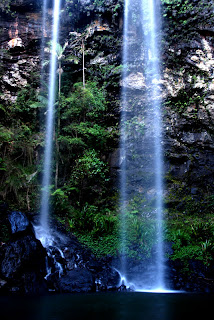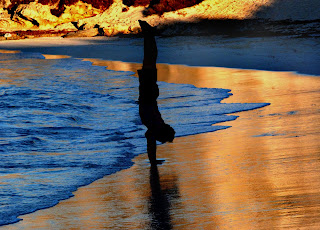 Nancy jumping for joy after spotting a Rock Parrot at Elephant Rocks (near Green Pool - of course)
Nancy jumping for joy after spotting a Rock Parrot at Elephant Rocks (near Green Pool - of course)After Nancy forced departure from the Pinnacles by (temporarily) taking Dirk's camera away, we cruised south and around Perth heading for the southern ocean. It is a fascinating area and we had to bypass a number of interesting places to stay within our allotted time. So first stop was the Dryandra Woodland south of Perth. The Dryandra forest is a rare remnant of the open Eucalypt woodland that was present before European clearing of the land in the Wheatbelt region for agriculture.

We didn't expect to see these two Bush Stone-curlews (do you see both of them?), and it appears they weren't particularly happy to see us! They are said to be "skulkers" but hey, that's just what it looks like when you're trying to hide and blend into your surroundings.

Party birds, they're not!

A juvenile red-capped robin? The best I could come up with for this cooperative but fairly nondescript birdie.

A rufous whistler. These birds are said to have an "impetuous, spirited spring song; the most 'Australian' of spring sounds." (Pizzey). Since it's now autumn, we didn't hear this song. Wonder if it's anything like our north American Western Meadowlark (my favorite springtime sound!).

We were lucky to happen upon "Barna Mia," an animal sanctuary nestled in the heart of the Dryandra. The people at this precious facility (government funded) are making a heroic effort in a breeding program for threatened/endangered marsupials. They are trying to reintroduce the native animals to their former habitats (including the Francois Peron National Park in Shark Bay) where their populations have been decimated due to feral predators, overgrazing, and land clearing including development.
A bilby! A recent search (this year) for a wild bilbies in WA revealed none whatsoever...(outside controlled nature reserves).

During our "spotlight" tour, we waited to see these little animals come for their food supplement of mushrooms, fruit, and pellets. Dirk took all these photos with no flash--illumination was by red spotlight to avoid spoiling the night vision of these nocturnal marsupials. Post -processing was only somewhat effective due to the original lighting.
A rufous hare-wallaby (or wurrup). The last two wild mainland populations of these guys were decimated in the early 1990s by fox predation and wildfire. Now they only survive on specially set-aside islands and enclosed sanctuaries like Barna Mia.

A Boodie or burrowing bettong. Said to be social, vocal marsupials that live in communal burrows, these little animals boisterously tried to steal the trays of food by pulling them towards their bodies and scooching backwards into the protective lean-to shelters where they could have all the food to themselves.
We also saw Woylies (or brush-tailed bettong) who primarily feed on underground fungi. They are not one of the better successes in the program--fungi are hard to come by in the prolonged drought of the area and wild populations are plummeting.

We looked high and low for Numbats - the locals all had the same story "we used to see [fill in the blank] every day, but now we almost never see them". Even in reserves many species are not doing well.
Project Numbat:
www.numbat.org.au
We traveled on the the Karri tree forests where we walked in the treetops and toured through some impressive old growth


This tree is still alive!

You used to be able to drive cars through the base of this (now dead) tree. "Loved to death," this cut-out car exhibit serves as an illustration about how the trees cannot survive root compaction. Now there are special boardwalks for walking, to protect the trees from overtrampling.

 OZ likes things BIG! Here is what I assume to be a life size diorama of the local ants. You DO NOT want these things joining your picnic!
OZ likes things BIG! Here is what I assume to be a life size diorama of the local ants. You DO NOT want these things joining your picnic!

Near Northcliffe, we found "Understory" a walk through the woods to connect to the spirit of the place through artist-inspired works.
In Albany we followed the birding notes Nancy found online and headed out about Oyster Harbour on the Coraki Cottage trail. We soon ran into some knowledgeable local twitchers (who looked at my sandals and commented "Nice shoes - for the Tiger snakes!" Appropriately chastened, I went back to the car to change.... They were very friendly and kindly shared their favorite birding haunts.

An regal-looking Australian Hobby, quite similar in appearance to his relative, the Peregrine Falcon.

Yellow-billed spoonbills chowing down for Breakfast near the King River Bridge.

An unlikely bird combo in a dead tree--an Australian Hobby (top), a Galah (pink, middle), and a ring-necked parrot (bottom).
 Emerald Pool/Elephant rocks. We stopped at this beautiful bay, a protected area perfect for swimming with no people around since it was early morning. Though it was a cool morning, when I saw a dolphin swimming around in the shallow water, I couldn't resist joining her for a quick dip. A magical place, this is where we were fortunate enough to see a lovely Rock Parrot!
Emerald Pool/Elephant rocks. We stopped at this beautiful bay, a protected area perfect for swimming with no people around since it was early morning. Though it was a cool morning, when I saw a dolphin swimming around in the shallow water, I couldn't resist joining her for a quick dip. A magical place, this is where we were fortunate enough to see a lovely Rock Parrot!

Although the rock parrots are not one of the more glamorous parrots, we found her to be quite endearing as she went about her business of eating breakfast.


A Red-winged Fairy-wren heading into "eclipse" (non-breeding) brown plumage.

A common bronzewing taking a stroll on the beach (!)

A rather odd-looking musk duck at Lake Sepping


Beautiful woods at Dryandra

Karri trees - thee things are immense. Like many living things in OZ, they are restricted to just a small corner of the continent. These have been saved from logging but the increasing drought is threatening their range....

Beautiful bark patterns.


At the Natural Arch I scoffed at the numerous signs warning of the "25 m cliff!" Wow - 25 whole meters! But as I walked up to the edge and I was struck by the potential danger of the place. If you pitched into the ocean there was no place - at all- you were going to get out of the water.
It wasn't until I walked away that I realized how silly that was - if you pitched 75' off a cliff anywhere, chances are slim you would walk away..


Dramatic storm lighting on a nice wave break way offshore...

A Sacred Kingfisher

White sands, green water over the reef transitioning to blue. Lovely spot....

The Cape Leeuwin Lighthouse, marking the most southwesterly point of Australia.

With the rainbows comes the rain (or is it the other way round...?)

Dipping a toe in the southern ocean - not a great day fora swim.
 Dirk jonesing to catch a wave at Margaret River - a world class surf destination. But howling winds and sloppy surf were keeping everyone out of the water - just standing on the rail was an effort! Saw two dirt-bag surfers (you know the type - beater car, full of bits and pieces of camping gear, food containers, sleeping bags - and 4 sticks on the roof!) pull up, take a squizz and just leave.
Dirk jonesing to catch a wave at Margaret River - a world class surf destination. But howling winds and sloppy surf were keeping everyone out of the water - just standing on the rail was an effort! Saw two dirt-bag surfers (you know the type - beater car, full of bits and pieces of camping gear, food containers, sleeping bags - and 4 sticks on the roof!) pull up, take a squizz and just leave.


 A more cooperative female Riflebird showing her long white brow.
A more cooperative female Riflebird showing her long white brow.
 We are thinking of developing a definitive guide to identification of birds when one can only see the birds buttt! Here's shy Mr. Wompoo's butt, (or bum, as they are know here) finally turns to look at me.
We are thinking of developing a definitive guide to identification of birds when one can only see the birds buttt! Here's shy Mr. Wompoo's butt, (or bum, as they are know here) finally turns to look at me.
 A Yellow-tailed Black-Cockatoo peering through the Springbrook forest at us, in between bark shredding. We could also hear these guys from far away, with their "carrying, wailing calls, 'why-eela, weela.'"(which go on, and on, nad on....). The red eye-ring and dark bill distinguishes the guys from the girls. They were simply shredding the bark off this tree.
A Yellow-tailed Black-Cockatoo peering through the Springbrook forest at us, in between bark shredding. We could also hear these guys from far away, with their "carrying, wailing calls, 'why-eela, weela.'"(which go on, and on, nad on....). The red eye-ring and dark bill distinguishes the guys from the girls. They were simply shredding the bark off this tree. A female Australian Wood Duck in a small park near Currumbin, displaying her stylish black and white chequered front. She cooperated with Morcombe's advice that she "must be seen at close range for the delicately patterned beauty of its [her] plumage to be appreciated."
A female Australian Wood Duck in a small park near Currumbin, displaying her stylish black and white chequered front. She cooperated with Morcombe's advice that she "must be seen at close range for the delicately patterned beauty of its [her] plumage to be appreciated." We know this is a non-breeding Great Egret because of his lack of plumes and a long, kinked neck. Also, the "length of head and neck together, outstretched, is great than the body length." In the pond near Currumbin.
We know this is a non-breeding Great Egret because of his lack of plumes and a long, kinked neck. Also, the "length of head and neck together, outstretched, is great than the body length." In the pond near Currumbin.



.jpg) Lovely light through the canopy at lower Ballanjui Fall in Lamington kept Dirk busy trying to find the perfect rainbow and water combination.
Lovely light through the canopy at lower Ballanjui Fall in Lamington kept Dirk busy trying to find the perfect rainbow and water combination..jpg) Finally, the NYT had a 'picturing the world event (see http://www.nytimes.com/
Finally, the NYT had a 'picturing the world event (see http://www.nytimes.com/




















.jpg)

















































